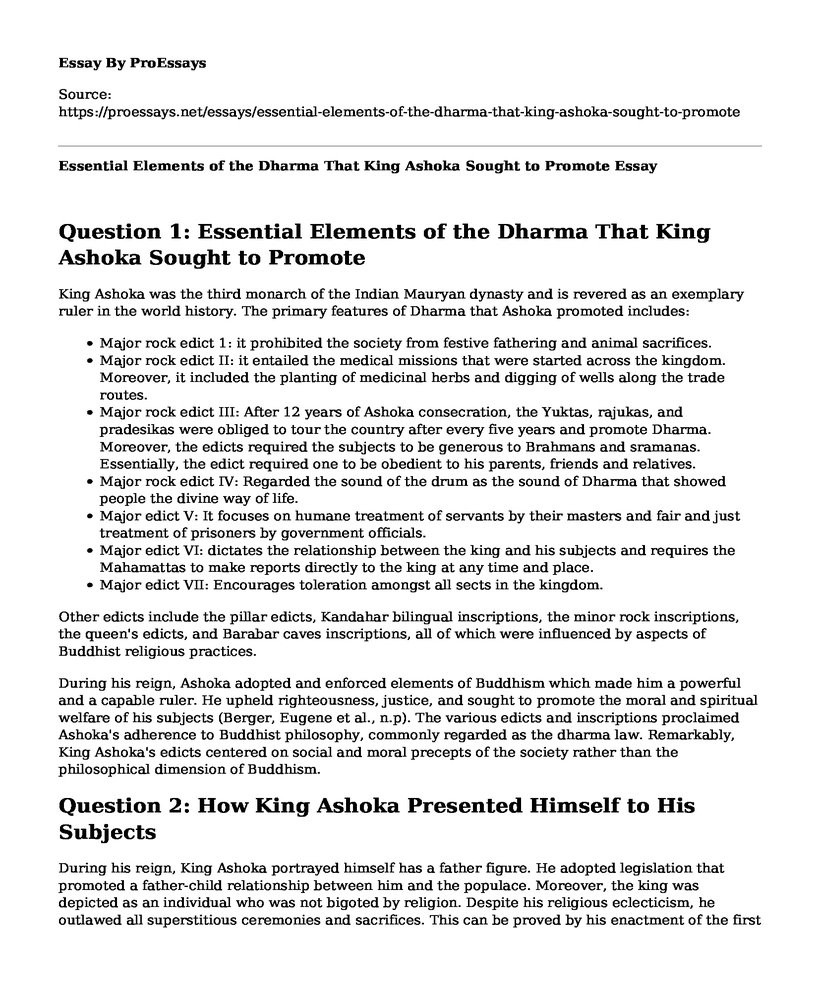Question 1: Essential Elements of the Dharma That King Ashoka Sought to Promote
King Ashoka was the third monarch of the Indian Mauryan dynasty and is revered as an exemplary ruler in the world history. The primary features of Dharma that Ashoka promoted includes:
- Major rock edict 1: it prohibited the society from festive fathering and animal sacrifices.
- Major rock edict II: it entailed the medical missions that were started across the kingdom. Moreover, it included the planting of medicinal herbs and digging of wells along the trade routes.
- Major rock edict III: After 12 years of Ashoka consecration, the Yuktas, rajukas, and pradesikas were obliged to tour the country after every five years and promote Dharma. Moreover, the edicts required the subjects to be generous to Brahmans and sramanas. Essentially, the edict required one to be obedient to his parents, friends and relatives.
- Major rock edict IV: Regarded the sound of the drum as the sound of Dharma that showed people the divine way of life.
- Major edict V: It focuses on humane treatment of servants by their masters and fair and just treatment of prisoners by government officials.
- Major edict VI: dictates the relationship between the king and his subjects and requires the Mahamattas to make reports directly to the king at any time and place.
- Major edict VII: Encourages toleration amongst all sects in the kingdom.
Other edicts include the pillar edicts, Kandahar bilingual inscriptions, the minor rock inscriptions, the queen's edicts, and Barabar caves inscriptions, all of which were influenced by aspects of Buddhist religious practices.
During his reign, Ashoka adopted and enforced elements of Buddhism which made him a powerful and a capable ruler. He upheld righteousness, justice, and sought to promote the moral and spiritual welfare of his subjects (Berger, Eugene et al., n.p). The various edicts and inscriptions proclaimed Ashoka's adherence to Buddhist philosophy, commonly regarded as the dharma law. Remarkably, King Ashoka's edicts centered on social and moral precepts of the society rather than the philosophical dimension of Buddhism.
Question 2: How King Ashoka Presented Himself to His Subjects
During his reign, King Ashoka portrayed himself has a father figure. He adopted legislation that promoted a father-child relationship between him and the populace. Moreover, the king was depicted as an individual who was not bigoted by religion. Despite his religious eclecticism, he outlawed all superstitious ceremonies and sacrifices. This can be proved by his enactment of the first major rock edict which prohibits animal sacrifices and festive gatherings. Additionally, King Ashoka portrayed himself to the populace as a generous, charismatic, and shrewd ruler (Flood 3). This can be depicted by his second rock edict that describes his construction of roads, medical centers, and environmental protection through the planting of medicinal herbs. Finally, Ashoka delineated himself has a peaceful ruler; he adopted the policy of Dharma in an attempt to eliminate social tension and sectarian conflict that were common in his kingdom. The Dharma was not a new set of laws; rather, it was people's way of life, a code of behavior and a conventional of moral values that guided people in their daily lives.Question 3: Why King Ashoka Chose to Issue These Edicts
Various reasons can be deduced as to why Ashoka adopted the various edicts. To start with, he desired to proclaim his adherence to the teachings of Buddha and the Buddhism philosophy. The inscriptions were his efforts to spread Buddhism across the kingdom. Secondly, the edicts were established to accentuate the role of Ashoka as the spiritual leader of his subjects. In the inscriptions, Ashoka is referred to as the Devanampiyadasi, which means the beloved servant of gods (Flood 8). Additionally, the edicts were meant to proclaim Ashoka's ideas on administration, governance, religion, and peoples roles and obligations towards each other, the government, and other religious groups. Finally, the policy of Dharma was adopted as a way of solving some of the complex tensions and problems that faced the society during his reign.
Works Cited
Berger, Eugene et al., "World History: Culture, States and Societies to 1500." University Press of North Georgia. 2016.
Flood, Gavan. "History of Hinduism." August 2009, pp. 1-12.
Cite this page
Essential Elements of the Dharma That King Ashoka Sought to Promote. (2022, Apr 04). Retrieved from https://proessays.net/essays/essential-elements-of-the-dharma-that-king-ashoka-sought-to-promote
If you are the original author of this essay and no longer wish to have it published on the ProEssays website, please click below to request its removal:
- War Is a Racket (by Smedley D. Butler)
- Paper Example on Terrorism After Cold War
- Essay Example on Rebel Without a Cause: The Impact of Teens in 1955
- Research Paper on Pearl Harbor Attack: US, UK, and Allies Join Forces Against Japan
- War: A Human History of Destruction and Death - Essay Sample
- Essay Example on Armenian Genocide: 600,000-1.5 Million Lives Lost, Turkish Denial
- All Quiet on the Western Front: Exploring the Experiences of Young Soldiers in WWI - Free Paper







